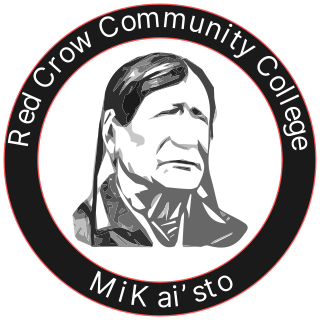
The Blackfoot Confederacy, Niitsitapi, or Siksikaitsitapi, is a historic collective name for linguistically related groups that make up the Blackfoot or Blackfeet people: the Siksika ("Blackfoot"), the Kainai or Blood, and two sections of the Peigan or Piikani – the Northern Piikani (Aapátohsipikáni) and the Southern Piikani. Broader definitions include groups such as the Tsúùtínà (Sarcee) and A'aninin who spoke quite different languages but allied with or joined the Blackfoot Confederacy.

Lethbridge is a city in the province of Alberta, Canada. With a population of 106,550 in the 2023 municipal census. Lethbridge became the fourth Alberta city to surpass 100,000 people. The nearby Canadian Rocky Mountains contribute to the city's warm summers, mild winters, and windy climate. Lethbridge lies southeast of Calgary on the Oldman River.

The Saint Mary River, is a cross-border tributary of the Oldman River, itself a tributary of the South Saskatchewan River. The Saint Mary together with the Belly River and Waterton River drains a small portion of Montana, in the United States, to the Hudson Bay watershed in Canada.

The Kainai Nation is a First Nations band government in southern Alberta, Canada, with a population of 12,965 members in 2024, up from 11,791 in December 2013.

The University of Lethbridge is a public comprehensive and research higher education institution located in Lethbridge, Alberta, Canada, with a second campus in Calgary, Alberta.

Medicine Hat—Cardston—Warner is a federal electoral district in southern Alberta, Canada, that has been represented in the House of Commons of Canada since 1908.
The Alberta University of the Arts (AUArts) is a public art university located in Calgary, Alberta, Canada. The university is a co-educational institution that operates four academic schools.

The Piikani Nation is a First Nation, representing the Indigenous people in Canada known as the Northern Piikani or simply the Peigan.
Picture Butte is a town in southern Alberta, Canada. It is located 27 km (17 mi) north of the city of Lethbridge. It claims the title of "Livestock Feeding Capital of Canada."

The Tsuutʼina Nation, also spelled Tsuu Tʼina or Tsu Tʼina, is a First Nation band government in Alberta, Canada. The Tsuu T'ina Nation 145 reserve is located directly west of Calgary, with its eastern edge directly adjacent to the southwest city limits. Their traditional territory spans a much larger area in southern Alberta. The land area of the current reserve is 283.14 km2, and it had a population of 1,982 in the 2001 Canadian census. The northeast portion of the reserve was used as part of CFB Calgary, a Canadian Army base, from 1910 to 1998. In 2006, the land was returned to the Nation by the Government of Canada.

Fort Whoop-Up was the nickname given to a whisky trading post, originally Fort Hamilton, near what is now Lethbridge, Alberta. During the late 19th century, the post served as a centre for trading activities, including the illegal whisky trade. The sale of whisky was outlawed but, due to the lack of law enforcement in the region prior to 1874, many whisky traders had settled in the area and taken to charging unusually high prices for their goods.

Writing-on-Stone Provincial Park is located about 100 kilometres (60 mi) southeast of Lethbridge, Alberta, Canada, or 44 kilometres (30 mi) east of the community of Milk River, and straddles the Milk River itself. It is one of the largest areas of protected prairie in the Alberta park system, and serves as both a nature preserve and protection for many First Nations (indigenous) rock carvings and paintings. The park is sacred to the Blackfoot and many other aboriginal tribes.

Stirling is a village in southern Alberta, Canada that is surrounded by the County of Warner No. 5. The village is located on Highway 4, approximately 31 km (19 mi) southeast of Lethbridge and 72 km (45 mi) northwest of the Canada–US border.

The modern history of Lethbridge extends to the mid-19th century, when the area was developed from drift mines opened by Nicholas Sheran in 1874, and the North Western Coal and Navigation Company in 1882. Prior to the development of drift mines in the area, Lethbridge, Alberta was known as Coal Banks, and was part of the territory of the Blackfoot Confederacy. The Confederacy was made up of the Kainai Nation, the Northern Peigan, the Southern Peigan (Blackfeet), and the Siksika Nation.

Red Crow Community College is a college located on the Kainai Nation reserve in southern Alberta, Canada with a campus in Lethbridge.

The Galt Museum & Archives Akaisamitohkanao’pa is the primary museum in Lethbridge, Alberta, Canada, and is the largest museum in the province south of Calgary. In 2006, the museum cared for a growing collection of over 20,000 artifacts and 300,000 archival documents and photographs record the history of Lethbridge and southern Alberta. It attracts over 50,000 visitors every year.

The Lethbridge Public Library is a public library service that is provided by the municipality of Lethbridge, Alberta, Canada. It was established in 1919. While it has had as many as three branches at one time, the library currently has two branches.
Janice Tanton is a Canadian artist.
Chin is a hamlet in southern Alberta, Canada within the Lethbridge County. It is located 1 kilometre (0.62 mi) north of Highway 3, approximately 27 kilometres (17 mi) east of Lethbridge.
Leroy Little Bear is a Blackfoot researcher, professor emeritus at the University of Lethbridge, founding member of Canada's first Native American Studies Department, and recognized leader and advocate for First Nations education, rights, self-governance, language and culture. He has received numerous awards and recognition for his work, including the Officer Order of Canada, and the Alberta Order of Excellence.















